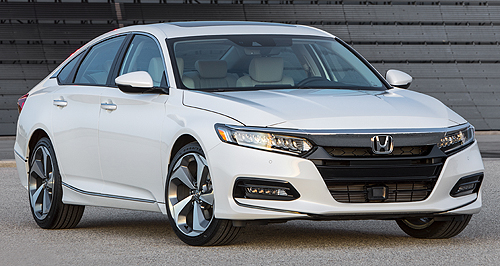Make / Model Search
Future models - Honda - AccordNew Honda Accord gets Civic Type R powerCivic relations: In addition to borrowing some styling elements from its smaller stablemate, the 10th-generation Honda Accord shares the Civic’s turbo-petrol engines – including a version of the Type R hot hatch powerplant. Aussie due date remains a mystery as 10th-gen Honda Accord takes a bow in the USGallery Click to see larger images 17 Jul 2017 THE 10th-generation Honda Accord will have no V6 engine option, instead deploying a version of the 2.0-litre turbo-petrol engine from the Civic Type R hot hatch in top-spec variants. Honda unveiled the new mid-sizer in the United States over the weekend, but the company’s Australian division is still working on a business case to bring the car here, meaning launch timing and whether the Type R-derived powertrain will be included on locally delivered models remains unknown. Unlike the manual-only Civic Type R, the Accord will send power to the front wheels via a new 10-speed automatic transmission that was developed in-house by Honda. The engine is also detuned from the hot hatchback’s searing 228kW of peak power and 400Nm of torque to a merely muscular 191kW/342Nm. Lower-spec variants will use the 1.5-litre turbo-petrol engine that powers mid-to-high spec mainstream Civics, with the wick turned up from 127kW/220Nm to 145kW/260Nm and paired with a continuously variable automatic transmission (CVT). Both turbo-petrol engines will also be available with manual transmissions in the US market. The new Accord is also available as a hybrid, which uses a pair of what Honda claims to be the world’s first electric drive motors to use magnets containing no heavy rare-earth metals to assist a 2.0-litre Atkinson cycle petrol engine that is more than 40 per cent thermally efficient – a higher rating than any mass-produced Honda engine to date. Although the new Accord is 10mm shorter than the outgoing model, it rides on a 55mm-longer wheelbase and sits 15mm lower, while also being 10mm broader and on wheel tracks that are 5mm wider at the front and 20mm at the back. Its A-pillars are also 20 per cent narrower than before and moved further back relative to the driving position. The result is shorter overhangs and a more cab-back stance with cues taken from the Civic sedan’s distinctive fastback-like styling but with a distinct – if somewhat shortened – rear deck that still provides a sedan silhouette. Overall the effect is more mature and conservative than the edgy Civic, especially the toned-down and slimmer version of the smaller car’s boomerang-like tail-light clusters. Up front the family resemblance is clearer, especially when compared with up-spec Civic sedans that have distinctive LED headlights – a technology that has been inherited by the Accord, along with its semi-clamshell bonnet design. Extending the wheelbase has boosted rear legroom by 50mm and boot space has increased by 28 litres on turbo-petrol variants. By relocating the Accord hybrid’s battery pack and new, more compact power electronics beneath the floor, boot space on those variants has grown 90L, to equal the non-hybrid capacity of 473L, while enabling the fitment of those cars’ 60/40 split-fold rear seats. A three-tier dashboard with 7.0-inch digital instrument pack and floating 8.0-inch touchscreen infotainment display with Apple CarPlay and Android Auto connectivity above the central air vents is made from soft-touch materials and sculpted to meet the door trims for a more premium look and feel. Similarly, the seats now have higher shoulder-level bolsters, variable-firmness padding, broader and more padded armrests. Up to 12-way electric adjustment, heating and ventilation is also available up front, with bottom and back heating in the rear seats. On-board technology will include a head-up display, traffic sign recognition, wireless inductive smartphone charging, automatic Bluetooth pairing using Near Field Communication, in-car 4G Wi-Fi and Tesla-style over-the-air software updates. Further connectivity includes remote unlocking/locking and engine start, stolen vehicle tracking, remote diagnostics and roadside assistance requests, geo-fencing (not allowing the car to operate outside a pre-set area) and speed tracking. In the US at least, every Honda will come with a full suite of active safety and driver assistance systems including autonomous emergency braking, lane departure warning, road departure mitigation and adaptive cruise control. Also available are blind spot monitoring, front and rear parking sensors, rear cross traffic alert and driver fatigue monitoring. This will be the first Accord to be constructed using structural adhesives, which Honda claims increase the model’s torsional and bending rigidity by 32 and 24 per cent respectively while contributing to a reduction in total vehicle weight of up to 80kg. Advancements in ride, handling and cabin quietness achieved through the increased body stiffness and reduced weight are taken further with a 10mm lower centre of gravity and a new suspension design that includes fluid-filled bushings, an all-aluminium front subframe and L-shaped aluminium control arms to which the Macpherson struts are attached. Rear suspension is a more space-efficient, multi-link design mounted to a floating rear subframe that has been made more rigid than before, and this will be the first Accord to feature electronically controlled adaptive dampers on all variants. The current-generation Accord, launched in May 2013 and facelifted in May last year, is produced in Thailand for Australia, while US market Accords are supplied by Honda’s Marysville plant in Ohio. It launched here almost a year after it was revealed in the US, providing some idea of when we might see the latest model Down Under. But the Accord’s future here is in doubt given that Australian sales of the nameplate have been plummeting since 2014, with double-digit losses every year. Just 719 were delivered in 2016 and a mere 188 have sold to the end of June this year.  Read more3rd of July 2017  Honda edges closer to Accord confirmationAccord nameplate to continue in tenth-gen guise if Honda Australia gets its way20th of June 2017  Honda teases tenth-gen US AccordNew Honda Accord teased ahead of July US unveiling, Aus future still unsureAll future models Alfa Romeo Alfa Romeo Abarth Abarth Alpine Alpine Alpina Alpina Audi Audi Aston Martin Aston Martin BMW BMW Bentley Bentley Chery Chery Brabham Brabham Chrysler Chrysler Chevrolet Chevrolet Cupra Cupra Citroen Citroen DS DS Dodge Dodge Fiat Fiat Ferrari Ferrari Foton Foton Ford Ford Great Wall Great Wall FPV FPV Haval Haval GWM GWM Honda Honda Holden Holden Hummer Hummer HSV HSV Infiniti Infiniti Hyundai Hyundai Jaguar Jaguar Isuzu Isuzu Kia Kia Jeep Jeep Land Rover Land Rover Lamborghini Lamborghini Lexus Lexus LDV LDV Mahindra Mahindra Lotus Lotus Mazda Mazda Maserati Maserati Mercedes-AMG Mercedes-AMG McLaren McLaren MG MG Mercedes-Benz Mercedes-Benz Mitsubishi Mitsubishi Mini Mini Opel Opel Nissan Nissan Peugeot Peugeot Pagani Pagani Proton Proton Porsche Porsche Renault Renault Ram Ram Rover Rover Rolls-Royce Rolls-Royce Skoda Skoda Saab Saab SsangYong SsangYong Smart Smart Suzuki Suzuki Subaru Subaru Toyota Toyota Tesla Tesla Volvo VolvoAccord pricingMotor industry news |
Click to shareHonda modelsResearch Honda All future models Alfa Romeo Alfa Romeo Abarth Abarth Alpine Alpine Alpina Alpina Audi Audi Aston Martin Aston Martin BMW BMW Bentley Bentley Chery Chery Brabham Brabham Chrysler Chrysler Chevrolet Chevrolet Cupra Cupra Citroen Citroen DS DS Dodge Dodge Fiat Fiat Ferrari Ferrari Foton Foton Ford Ford Great Wall Great Wall FPV FPV Haval Haval GWM GWM Honda Honda Holden Holden Hummer Hummer HSV HSV Infiniti Infiniti Hyundai Hyundai Jaguar Jaguar Isuzu Isuzu Kia Kia Jeep Jeep Land Rover Land Rover Lamborghini Lamborghini Lexus Lexus LDV LDV Mahindra Mahindra Lotus Lotus Mazda Mazda Maserati Maserati Mercedes-AMG Mercedes-AMG McLaren McLaren MG MG Mercedes-Benz Mercedes-Benz Mitsubishi Mitsubishi Mini Mini Opel Opel Nissan Nissan Peugeot Peugeot Pagani Pagani Proton Proton Porsche Porsche Renault Renault Ram Ram Rover Rover Rolls-Royce Rolls-Royce Skoda Skoda Saab Saab SsangYong SsangYong Smart Smart Suzuki Suzuki Subaru Subaru Toyota Toyota Tesla Tesla Volvo VolvoAccord pricingMotor industry news |



































Facebook Twitter Instagram